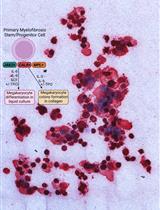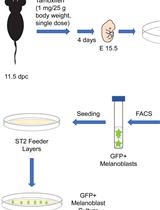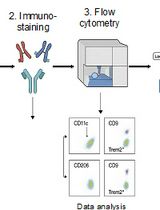- EN - English
- CN - 中文
Platelet Isolation and Activation Assays
血小板的分离和活化实验
发布: 2019年10月20日第9卷第20期 DOI: 10.21769/BioProtoc.3405 浏览次数: 12588
评审: Meenal SinhaXiaoyi ZhengAnonymous reviewer(s)

相关实验方案

来自骨髓增生性肿瘤患者的造血祖细胞的血小板生成素不依赖性巨核细胞分化
Chloe A. L. Thompson-Peach [...] Daniel Thomas
2023年01月20日 2297 阅读
Abstract
Platelets regulate hemostasis and are the key determinants of pathogenic thrombosis following atherosclerotic plaque rupture. Platelets circulate in an inactive state, but become activated in response to damage to the endothelium, which exposes thrombogenic material such as collagen to the blood flow. Activation results in a number of responses, including secretion of soluble bioactive molecules via the release of alpha and dense granules, activation of membrane adhesion receptors, release of microparticles, and externalization of phosphatidylserine. These processes facilitate firm adhesion to sites of injury and the recruitment and activation of other platelets and leukocytes, resulting in aggregation and thrombus formation. Platelet activation drives the hemostatic response, and also contributes to pathogenic thrombus formation. Thus, quantification of platelet-associated responses is key to many pathophysiologically relevant processes. Here we describe protocols for isolating, counting, and activating platelets, and for the rapid quantification of cell surface proteins using flow cytometry.
Keywords: Platelets (血小板)Background
Platelets are small circulating cells with key roles in the normal hemostatic response to vascular injury, and also in pathogenic thrombus formation resulting from, for example, atherosclerotic plaque rupture. Both hemostasis and plaque rupture result in exposure of thrombogenic material to the circulation, including collagen, von Willebrand factor (vWF), and also a variety of soluble platelet agonists released from damaged cells. Thrombin, generated as part of the coagulation cascade, is a potent platelet agonist that activates platelets via protease-activated receptors. Once activated, platelets undergo a number of processes, including shape change, degranulation of alpha and dense granules, secretion of bioactive molecules (including platelet agonists, such as thromboxane A2, ADP and serotonin), phosphatidylserine exposure, and receptor activation. Released soluble platelet agonists regulate autocrine and paracrine activation via GPCR signaling, resulting in the activation and recruitment of other platelets, and formation of a thrombus (Li et al., 2010).
Activation also results in upregulation of a number of adhesive receptors on the platelet surface. Principally, activation results in the ‘inside-out’ signaling processes that activate the fibrinogen receptor, integrin αIIbβ3 (glycoprotein IIb-IIIa), which is responsible for platelet-platelet interactions as a result of binding to fibrinogen. Activated αIIbβ3 also binds to vWF, further associating platelets to sites of vascular damage (Bennett, 1996). Activation also results in the externalization of P-selectin, which regulates leukocyte binding via its ligand P-selectin glycoprotein ligand-1. This results in the formation of platelet-leukocyte aggregates, which are essential for the delivery of pro-inflammatory cytokines to the damaged endothelium (Yun et al., 2016). Activation also causes loss of phospholipid asymmetry and exposure of phosphatidylserine (PS) on the outer leaflet of the membrane. This supports the formation of the prothrombinase complex (Monroe et al., 2002) and therefore the conversion of prothrombin into active thrombin (Lane et al., 2005).
In addition to hemostatic roles, soluble factors released from activated platelets also influence other processes. For example, interleukin-1 from activated platelets has proinflammatory roles in arthritis (Boilard et al., 2010), and cerebrovascular disease (Thornton et al., 2010). Therefore, the importance of measuring factors found on the surface and released from activated platelets is important to many areas of biology.
Here we describe several commonly used protocols that can be used to isolate and activate platelets, and quantify the proteins they express. These protocols can be easily adapted to look at other proteins of interest on platelets.
Materials and Reagents
- Glass tubes (Fisher, catalog number: 11852363)
- Pipette tips (Gilson, catalog numbers: F167104; F167103; F167101)
- Pipettes
- 1 ml syringe (BD, catalog number: 309628)
- 10 ml syringe (BD, catalog number: 305959)
- 50 ml syringe (BD, catalog number: 300865)
- 0.22 μm syringe filter (Merck, catalog number: SLGP033RS)
- 21 G syringe needle (Sarstedt, catalog number: 85.1162)
- 23 G syringe needle (BD, catalog number: 300800)
- 27 G syringe needle (BD, catalog number: 302200)
- 14 ml round-bottomed tubes (Falcon, catalog number: 352059)
- 1.5 ml microcentrifuge tubes (Trefflab, catalog number: 96.07811.9.03)
- 2 ml microcentrifuge tubes (Trefflab, catalog number: 96.09329.01)
- EDTA coated capillary tube (Sarstedt, catalog number: 16.444)
- Aggregometry cuvettes (aggregometer specific; e.g., Helena, catalog number: 1473)
- Mouse (Jackson Laboratory, catalog number: 000664)
- Bovine Serum Albumin (Sigma-Aldrich, catalog number: A3059)
- Collagen (Helena, catalog number: 5368)
- Thrombin (Merck, catalog number: 69671-3)
- ADP (Sigma-Aldrich, catalog number: A2754)
- Platelet Activating Factor (Sigma-Aldrich, catalog number: 511075)
- Platelet surface markers:
- Anti-human CD41-PE (for detection of Integrin alpha-IIb, Biolegend, clone: HIP8, catalog number: 303706)
- Anti-human CD42b-PE (for detection of GPIb, Biolegend, clone: HIP1, catalog number: 303905)
- Activated platelet markers:
- PAC-1-FITC (for detection of activated integrin αIIbβ3, Thermofisher, clone: PAC-1, catalog number: MA5-28564)
- Anti‐CD62P‐FITC (for detection of alpha granule release, Biolegend, clone: AK4, catalog number: 304903)
- Anti-CD63-AF488 (for detection of dense granule release, Thermofisher, clone: MEM-259, catalog number: MA5-18149)
- Anti-human Annexin V-FITC (Biolegend, catalog number: 640914)
- Anti-human IL-1α-FITC (R&D, clone: 3405, catalog number: FAB200F)
- Rat monoclonal anti-mouse CD42b (Emfret, catalog number: R300)
- Sodium citrate (Sigma-Aldrich, catalog number: C8532)
- Atroxin (Sigma-Aldrich, catalog number: 11335)
- Hank’s Balanced Salt Solution (HBSS) (Sigma-Aldrich, catalog number: H9394)
- EDTA (Sigma-Aldrich, catalog number: E5134)
- Calcium Chloride (Sigma-Aldrich, catalog number: C7902)
- Cross-linked Collagen related peptide (CRP-XL) (Professor Richard Farndale, Dept. Biochemistry, Cambridge, https://collagentoolkit.bio.cam.ac.uk/thp/generic)
- Phosphate Buffered Saline (Sigma-Aldrich, catalog number: D8537)
- Sodium Azide (Sigma-Aldrich, catalog number: S2002)
- β-mercaptoethanol (Sigma-Aldrich, catalog number: M6250)
- Tris base (Sigma-Aldrich, catalog number: T6066)
- SDS (Sigma-Aldrich, catalog number: 75746)
- Bromophenol blue (Sigma-Aldrich, catalog number: 114391)
- Glycerol (Sigma-Aldrich, catalog number: G5516)
- Liquid nitrogen
- Deionized water
- Hydrochloric acid
- Serum-free DMEM (Sigma-Aldrich, catalog number: 05671)
- Calcium-free Tyrode’s buffer (Boston BioProducts, catalog number: BSS-350)
- Sodium citrate for anticoagulation of blood (see Recipes)
- Hank’s Balanced Salt Solution (HBSS) with EDTA (see Recipes)
- FACs buffer (see Recipes)
- Laemmli buffer (see Recipes)
Equipment
- -20 °C freezer
- Centrifuge with swing out rotor suitable for 15 ml tubes (Eppendorf, model: 5810R)
- Sonicator (Diagenode, Bioruptor, model: UCD-200)
- Accuri flow cytometer (BD, model: C6)
- Liquid nitrogen dewar
- Microbalance
- 37 °C incubator
- Warming box for rodents (Able Scientific, model: ASHE011AR)
- Mouse restrainer (Braintree Scientific, model: SHORTI STD)
- Weighing scales
- AggRAM Aggregometer (Helena Biosciences, model 110/220)
- Protein gel electrophoresis equipment
Software
- C6 Analysis Software (BD Accuri, catalog number: 653122), or other appropriate analysis software.
Procedure
文章信息
版权信息
© 2019 The Authors; exclusive licensee Bio-protocol LLC.
如何引用
Burzynski, L. C., Pugh, N. and Clarke, M. C. (2019). Platelet Isolation and Activation Assays. Bio-protocol 9(20): e3405. DOI: 10.21769/BioProtoc.3405.
分类
分子生物学 > 蛋白质 > 检测
免疫学 > 宿主防御 > 综合
细胞生物学 > 细胞分离和培养 > 细胞分离 > 流式细胞术
您对这篇实验方法有问题吗?
在此处发布您的问题,我们将邀请本文作者来回答。同时,我们会将您的问题发布到Bio-protocol Exchange,以便寻求社区成员的帮助。
Share
Bluesky
X
Copy link












